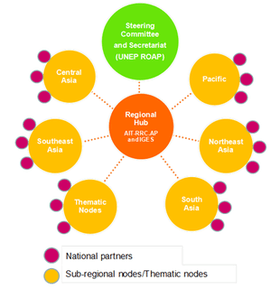Asia Pacific Adaptation Network
Asia Pacific Adaptation Network (APAN) was established in October 2009 as part of the Global Adaptation Network (GAN). It is the first network under the GAN supported by the UNEP, IGES, AIT-UNEP RRCAP, ADB, SIDA, and APN.


Structure of APAN
The Regional Hub (RH) is co-hosted by the Asian Institute of Technology – UNEP Regional Resource Centre for Asia-Pacific (AIT- UNEP RRC.AP) and the Institute for Global Environmental Strategies (IGES) in Bangkok, Thailand. The Regional Hub is the implementing body of the Network at the regional level (where relevant)
The Network has five Sub-Regional Nodes (SRNs) covering five sub-regions in Asia-Pacific. SRNs are organisations whose key functions are to lead the implementation of the sub-regional activities of the Network in collaboration with the RH and national implementing partners. The three Thematic Nodes (TNs) of APAN on water, agriculture and mountains reflect the current priorities of the region and are composed of organizations with specific expertise on their respective thematic areas.
| Sub-regional Nodes |
|---|
| Central Asia - Central Asia Regional Economic Cooperation (CAREC) |
| Northeast Asia - Keio University (Keio) |
| Pacific - Secretariat of the Pacific Regional Environment Programme (SPREP) |
| Southeast Asia - ICLEI-Local Governments for Sustainability (ICLEI) |
| Thematic Nodes |
| Water - Global Water Partnership (GWP) |
| Mountain - International Centre for Integrated Mountain Development (ICIMOD) |
| Agriculture - Southeast Asia Regional Centre for Graduate Study and Research in Agriculture |
Activities
- Knowledge generation, management, sharing and exchanging through collection, synthesis, packaging and dissemination of adaptation-related data, information and knowledge at regional, sub-regional and national levels such as good practice and technology databases
- Capacity building by coordinating and facilitating the implementation of the activities described in the Implementation Plan 2010-2011 under the guidance of the Steering Committee for national, sub-regional and regional actors through meetings, seminars, workshops and trainings with the support from the sub-regional nodes and thematic nodes
- Facilitating access to adaptation finance and technologies
- Identification of specific gaps and needs in knowledge, information and technologies for CCA and priority areas at the country and the sub-regional levels through dialogues with national implementing partners and regional entities
- Establishing and strengthening linkages and collaboration with networks, initiatives, national centers of excellence, donor agencies, governments and other specialized institutions working on CCA in the countries of the sub-regions
Activities Outcomes and Publications
- All activities of APAN, including summaries, outcomes, agenda, proceedings report and PPT files can be found at APAN's Activities
- All publications of APAN have been made through the knowledge gained by its activities in the region which are training, seminars and workshops to disseminate knowledge on climate adaptation as well as to build capacities for climate adaptation and for the development of good adaptation practices.[1]
- The e-communiqué is part of the Regional Climate Change Adaptation Knowledge Platform (AKP) for Asia and Asia Pacific Adaptation Network’s efforts to share and inform about its activities, topical climate change adaptation news and initiatives from Asia and the Pacific and beyond.[2]
Adaptation Forum
Once a year APAN co-organizes the Asia Pacific Climate Change Adaptation Forum that attracts worldwide scientists, development workers, government officials, academicians, international organizations, students, and representatives from civil society who come together to discuss climate change adaptation topics.
Featured Online Knowledge Products
Database of Good Practices on Climate Change Adaptation
Explore a database of good adaptation practices from all over Asia and the Pacific which were identified from the studies conducted by APAN in collaboration with development and research institutions in the different regions in Asia and the Pacific.[3]
Database of Adaptation Technologies
A database of adaptation technologies for coastal zones was identified by a research by a consulting firm to promote the smooth formulation and implementation of policy when policymakers of national or local governments implement the series of adaptation steps, while adequately considering information that can be useful at the local level.[4]
References
- APAN's Publications
- APAN-AKP's ecommuniqué Archived September 4, 2011, at the Wayback Machine
- Database
- Database